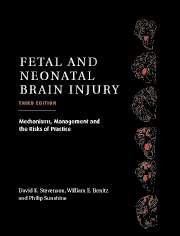Book contents
- Frontmatter
- Contents
- List of contributors
- Foreword
- Preface
- Part I Epidemiology, Pathophysiology, and Pathogenesis of Fetal and Neonatal Brain Injury
- Part II Pregnancy, Labor, and Delivery Complications Causing Brain Injury
- Part III Diagnosis of the Infant with Asphyxia
- Part IV Specific Conditions Associated with Fetal and Neonatal Brain Injury
- Part V Management of the Depressed or Neurologically Dysfunctional Neonate
- Part VI Assessing the Outcome of the Asphyxiated Infant
- 40 Assessment of preterm infants' neurobehavioral functioning: reliability, validity, normative data, and prediction to age two
- 41 Long-term follow-up of term infants with perinatal asphyxia
- 42 Appropriateness of intensive care application
- 43 Medicolegal issues in perinatal brain injury
- Index
- Plate section
43 - Medicolegal issues in perinatal brain injury
from Part VI - Assessing the Outcome of the Asphyxiated Infant
Published online by Cambridge University Press: 10 November 2010
- Frontmatter
- Contents
- List of contributors
- Foreword
- Preface
- Part I Epidemiology, Pathophysiology, and Pathogenesis of Fetal and Neonatal Brain Injury
- Part II Pregnancy, Labor, and Delivery Complications Causing Brain Injury
- Part III Diagnosis of the Infant with Asphyxia
- Part IV Specific Conditions Associated with Fetal and Neonatal Brain Injury
- Part V Management of the Depressed or Neurologically Dysfunctional Neonate
- Part VI Assessing the Outcome of the Asphyxiated Infant
- 40 Assessment of preterm infants' neurobehavioral functioning: reliability, validity, normative data, and prediction to age two
- 41 Long-term follow-up of term infants with perinatal asphyxia
- 42 Appropriateness of intensive care application
- 43 Medicolegal issues in perinatal brain injury
- Index
- Plate section
Summary
Perinatal hypoxic–ischemic brain injury is an important and often troublesome medicolegal problem for practicing physicians. Brain injury to infants occurring during the perinatal period is probably the most common cause of severe long-term neurological deficit in patients, consequently the incentive for legal action is high.
Although vast advances in care have taken place during the past several decades in the practice of perinatal medicine, the incidence of brain injury and its sequelae has not seen a significant decline. Litigation involving these types of injuries has remained a constant over many years despite endeavors in education of both physicians and patients, and improvements in care. This chapter will attempt to explore and explain the manner in which legal principles are applied to complex medical issues in the medicolegal examination of perinatal brain injury.
The term “medical malpractice,” often misused and frequently misunderstood, refers to any professional act or omission to act that encompasses or represents an unreasonable lack of knowledge, care, or skill in carrying out one's professional duties. As used herein the term “medical malpractice” is synonymous with medical “negligence.”
Although there are a number of legal theories which may be brought against a physician for allegedly fault-worthy conduct in perinatal or other medical context.
- Type
- Chapter
- Information
- Fetal and Neonatal Brain InjuryMechanisms, Management and the Risks of Practice, pp. 873 - 886Publisher: Cambridge University PressPrint publication year: 2003



